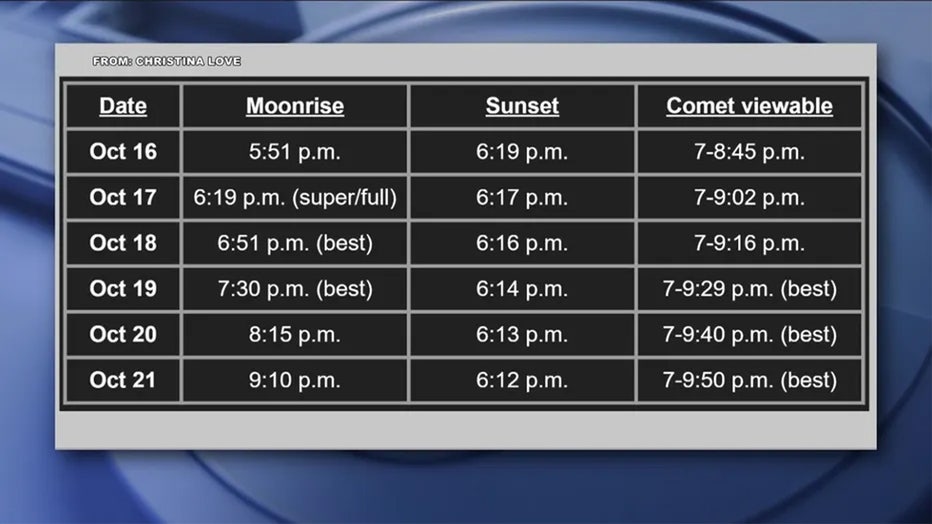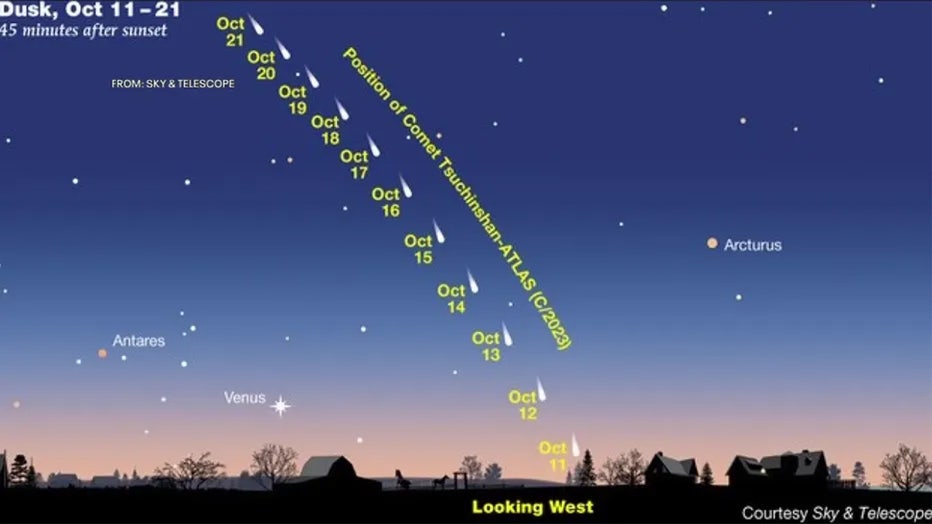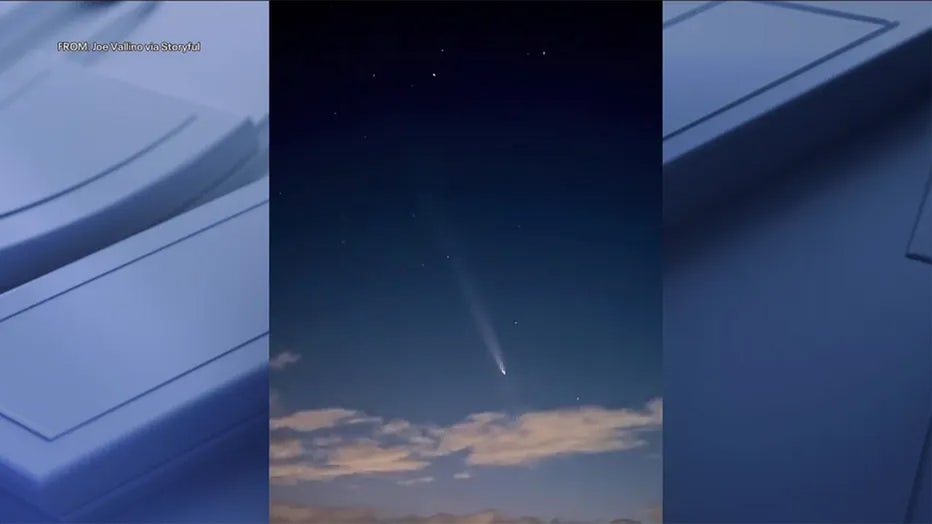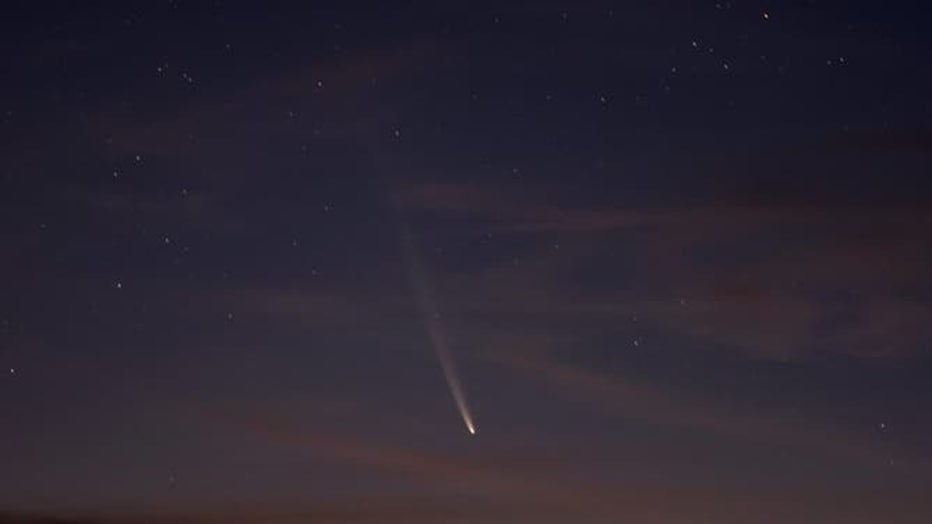Atlas comet tracker: How to see it tonight, weather forecast, and more
Comet Tsuchinshan-Atlas, the C/2023 A3 Tsuchinshan-Atlas comet, the brightest comet of the last 13 years is observed over the sky in Van, Turkiye on October 15, 2024. (Photo by Ozkan Bilgin/Anadolu via Getty Images)
NEW YORK - Tonight would be a great time for New Yorkers to look for a comet in the sky.
Outer space is giving stargazers a rare, celestial treat - an icy comet that will take 80,000 years to return – if it survives the trip – in the night sky!
Here's everything you need to know about the Atlas comet, including where it came from, how and when to view it and this week's weather forecast for curious New Yorkers. Plus, the comet's visibility may coincide with the peak of the Orionid meteor shower!
JUMP TO WHEN TO VIEW | NYC WEATHER FORECAST | WHERE DID THE COMET COME FROM? | WHEN WILL THE COMET RETURN? | ORIONOID METEOR SHOWER
When to view the comet tonight
Those hoping to spot the comet should venture outside about an hour after sunset on a clear night and look to the west.

Sunset is expected to begin at 6:12 in our area.
The moon is set to rise at 9:10 p.m.
The best time to view the comet tonight is between 7:50-9 p.m.
The comet should be visible from both the northern and southern hemispheres.
Astronomers say it will stay visible throughout most of the month as it slings towards Earth in the outer reaches of the solar system. According to Space.com, stargazers can keep looking for the comet until Oct. 26.

"As author David H. Levy wrote in Comets: Creators and Destroyers, "comets are like cats: they have tails, and they do precisely what they want." Arm yourself with a good pair of binoculars, and you'll have a chance to see comet Tsuchinshan-ATLAS for some time," Space.com's Jamie Carter wrote.
NYC forecast this week
On Monday, New Yorkers can expect summer-like temperatures which are ideal conditions for comet viewing.
Here's the weather forecast for the rest of the week:
- Monday: Summer like, High of 81.
- Tuesday: Nice day. High of 78. Low of 61.
- Wednesday: Mild temps. High of 76. Low of 58.
- Thursday: Cooler temps. High of 63. Low of 54.
- Friday: Chilly day. High 62. Low of 45.
Where did the comet come from?
The comet, also designated C/2023 A3, was discovered last year and is named for the observatories in China and South Africa that spied it.
It came from what’s known as the Oort Cloud well beyond Pluto. After making its closest approach about 44 million miles (71 million kilometers) of Earth, it won’t return for another 80,000 years — assuming it survives the trip.
Several comets are discovered every year, but many burn up near the sun or linger too far away to be visible without special equipment, according to Larry Denneau, a lead researcher with the Atlas telescope that helped discover the comet.
When will the comet return?

Astronomers say the comet could return in 80,000 years, but it's increasingly likely that due to the space rock's composition, it won't return at all.
"Most comets have these incredibly long periods and maybe don't even come back," Drexel University Physics Professor Christina Love said.
Halley's Comet, for comparison, is considered a once-in-a-lifetime celestial event that returns every 75 years or so.
Orionid meteor shower
The Orionids are one of two annual meteor showers from Halley's comet.
The Orionid meteor shower can be unpredictable. It shines like a fireworks display in some years, but is fairly slow in other years. This highly variable shower may result in anywhere from 20 to 60 visible meteors per hour under ideal viewing conditions, said NASA's Bill Cooke.

TOPSHOT - Comet C2023 A3 Tsuchinshan-Atlas is seen over the hills near the village of Aguas Blancas, Lavalleja Department, Uruguay, at dawn on September 28, 2024. (Mariana SUAREZ / AFP / Getty Images)
This year’s peak activity happens on a night when a waning moon is 83% full. The shower lasts through November 22.
The Associated Press contributed to this report.


